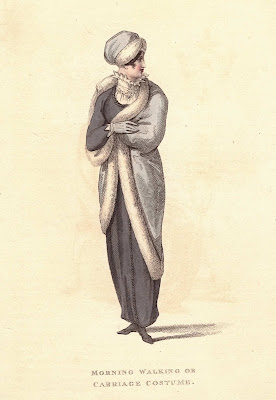After a very mild autumn, my neck of the woods is finally getting a sharp dose of winter today, with temperatures hovering in single digits (which is why I did anything that needed doing outdoors yesterday.) Of course, in today’s world we have central heating and insulated homes and amazing fabrics that keep us warm…and while winter temperatures in England aren’t generally as severe as those in the more northerly parts of North America, the world was still in the grip of the Little Ice Age and the Thames still occasionally froze over. So what did a Regency miss do when winter dogged her heels and nipped at her nose?
I’ve one word in answer to that question: fur.
Since down jackets and Gore-tex had yet to be invented, the warmest thing in outerwear that one could wear was fur…and our hypothetical Regency lady took full advantage of it. She might wear fur-lined pelisses and cloaks like some of these:
Carriage or Promenade Dress, Ackermann’s Repository, January 1810. Incidentally, this print and the next are among the only illustrations I’ve seen of fur used in millinery in Ackermann’s Repository; the other is a print from La Belle Assemblee that we looked at in detail a few years ago.
Morning Walking or Carriage Costume, Ackermann’s Repository, December 1810
Carriage Dress, Ackermann’s Repository, February 1820
Or maybe just settle for fur trim, as in this Walking Dress from the March 1822 Ackermann’s Repository.
And of course, there were those enormous, eye-catching muffs that were popular for decades...and no wonder: gloves were worn year round, but when glovemakers boasted of the fineness of the kidskin they used, something more would definitely be wanted in winter to keep the hands and forearms warm. (Promenade Dress, Ackermann’s Repository, January 1814)
So what kind of fur was worn?
Looking over years of Ackermann’s Repository images gives the impression that a lot of ermine (white fur decorated with the tufts of black tail fur) was worn. But actually reading the text accompanying the images tells a different tale (ahem): for example, the fur-lined mantle above from January 1810 is made with (are you ready?) “spotted American squirrel skin”! A coat from January 1811 (not shown here) was trimmed with blue fox fur. The February 1811 Walking Dress with the tippet and fur trim uses “astracan” (more commonly spelled astrakhan), or lamb. Other plates mention red fox, mole, leopard, sable, and chinchilla in addition to ermine.
While these prints are fascinating to look at, I have to say that I’m very grateful that we don’t have to follow their example any more. Now if you’ll excuse me, I think I’ll go have some quality time with my Primaloft quilt...







Those are pretty but I just couldn't wear real fur! In Dress in the Age of Jane Austen, Hilary Davidson details the woolen undergarments that would have been worn under their dresses. Plus she describes all the outwear too. I think I'd stick with flannel waistcoats and wool outerwear and curl up by the fire!
ReplyDelete